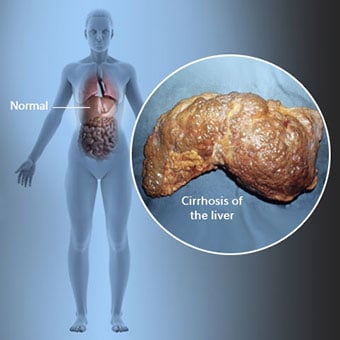 Cirhóza je komplikácia ochorenia pečene, ktorá zahŕňa stratu pečeňových buniek a nezvratné zjazvenie pečene.
Cirhóza je komplikácia ochorenia pečene, ktorá zahŕňa stratu pečeňových buniek a nezvratné zjazvenie pečene. Jedinci s cirhózou môžu mať málo alebo žiadne príznaky a príznaky ochorenia pečene. Niektoré symptómy môžu byť nešpecifické, to znamená, že nenaznačujú, že ich príčinou je pečeň. Niektoré z bežnejších symptómov a príznakov cirhózy zahŕňajú:
U jedincov s cirhózou sa tiež rozvinú symptómy a príznaky komplikácií cirhózy.
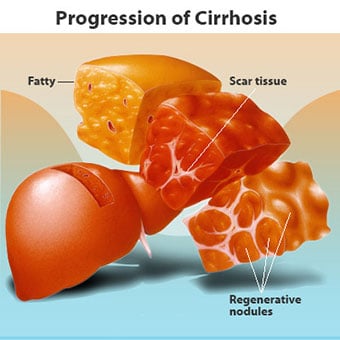 Existuje mnoho príčin cirhózy vrátane chemikálií (ako je alkohol, tuk a niektoré lieky), vírusov, toxických látok kovy a autoimunitné ochorenie pečene, pri ktorom imunitný systém tela napáda pečeň.
Existuje mnoho príčin cirhózy vrátane chemikálií (ako je alkohol, tuk a niektoré lieky), vírusov, toxických látok kovy a autoimunitné ochorenie pečene, pri ktorom imunitný systém tela napáda pečeň. Cirhóza je komplikáciou mnohých ochorení pečene charakterizovaných abnormálnou štruktúrou a funkciou pečene. Choroby, ktoré vedú k cirhóze, to robia preto, že poškodzujú a zabíjajú pečeňové bunky, po ktorých zápal a oprava, ktorá je spojená s odumierajúcimi pečeňovými bunkami, spôsobia tvorbu jazvového tkaniva. Pečeňové bunky, ktoré nezomrú, sa množia v snahe nahradiť bunky, ktoré odumreli. Výsledkom sú zhluky novovytvorených pečeňových buniek (regeneračné uzliny) v tkanive jazvy. Existuje mnoho príčin cirhózy vrátane chemikálií (ako je alkohol, tuk a niektoré lieky), vírusov, toxických kovov (ako je železo a meď, ktoré sa hromadia v pečeni v dôsledku genetických ochorení) a autoimunitného ochorenia pečene, pri ktorom imunitný systém tela útočí na pečeň.
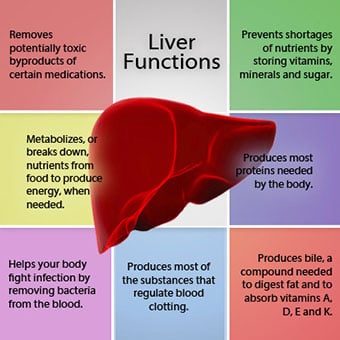 Vzťah pečene ku krvi je jedinečný.
Vzťah pečene ku krvi je jedinečný. Pečeň je dôležitý orgán v tele. Vykonáva mnoho kritických funkcií, z ktorých dve produkujú látky potrebné pre telo, napríklad zrážanie bielkovín, ktoré sú potrebné na zrážanie krvi, a odstraňovanie toxických látok, ktoré môžu byť pre telo škodlivé, napríklad lieky. . Pečeň má tiež dôležitú úlohu pri regulácii prísunu glukózy (cukru) a lipidov (tuku), ktoré telo využíva ako palivo. Aby mohli vykonávať tieto kritické funkcie, pečeňové bunky musia fungovať normálne a musia byť v tesnej blízkosti krvi, pretože látky, ktoré pečeň pridáva alebo odoberá, sú do a z pečene transportované krvou.
Vzťah pečene ku krvi je jedinečný. Na rozdiel od väčšiny orgánov v tele je do pečene dodávané len malé množstvo krvi tepnami. Väčšina zásob krvi pečene pochádza z črevných žíl, keď sa krv vracia do srdca. Hlavná žila, ktorá vracia krv z čriev, sa nazýva portálna žila. Keď portálna žila prechádza pečeňou, rozpadá sa na čoraz menšie a menšie žily. Najmenší žily (nazývané sínusoidy kvôli ich jedinečnej štruktúre) sú v tesnom kontakte s pečeňovými bunkami. Pečeňové bunky sú usporiadané pozdĺž sínusoidov. Tento úzky vzťah medzi pečeňovými bunkami a krvou z portálnej žily umožňuje pečeňovým bunkám odoberať a pridávať látky do krvi. Keď krv prejde cez sínusoidy, zhromažďuje sa v čoraz väčších a väčších žilách, ktoré nakoniec vytvoria jedinú žilu, pečeňovú žilu, ktorá vracia krv do srdca.
Pri cirhóze je vzťah medzi krvou a pečeňovými bunkami zničený. Aj keď pečeňové bunky, ktoré prežijú alebo sa novotvoria, môžu byť schopné produkovať a odstraňovať látky z krvi, nemajú normálny, intímny vzťah s krvou, čo narúša schopnosť pečeňových buniek pridávať alebo odoberať látky. z krvi. Okrem toho zjazvenie v cirhotickej pečeni bráni prietoku krvi cez pečeň a do pečeňových buniek. V dôsledku prekážky prietoku krvi pečeňou sa krv „hromadí“ v portálnej žile a zvyšuje sa tlak v portálnej žile, čo je stav nazývaný portálna hypertenzia. Kvôli prekážke prietoku a vysokému tlaku v portálnej žile krv v portálnej žile hľadá iné žily, v ktorých sa môže vrátiť do srdca, žily s nižším tlakom, ktoré obchádzajú pečeň. Bohužiaľ, pečeň nie je schopná pridávať alebo odoberať látky z krvi, ktoré ju obchádzajú. Je to kombinácia zníženého počtu pečeňových buniek, straty normálneho kontaktu medzi krvou prechádzajúcou pečeňou a pečeňovými bunkami a obchádzania krvi pečeňou, čo vedie k mnohým príznakom cirhózy.
Druhým dôvodom problémov spôsobených cirhózou je narušený vzťah medzi pečeňovými bunkami a kanálikmi, ktorými preteká žlč. Žlč je tekutina produkovaná pečeňovými bunkami, ktorá má dve dôležité funkcie:napomáhať pri trávení a odstraňovať a odstraňovať toxické látky z tela. Žlč produkovaná pečeňovými bunkami je vylučovaná do veľmi malých kanálikov, ktoré prebiehajú medzi pečeňovými bunkami, ktoré lemujú sínusoidy, nazývané canaliculi. Kanáliky sa vyprázdnia do malých kanálikov, ktoré sa potom spoja a vytvoria väčšie a väčšie kanáliky. Všetky kanály sa spájajú do jedného kanála, ktorý vstupuje do tenkého čreva, kde môže pomôcť pri trávení potravy. Zároveň sa toxické látky obsiahnuté v žlči dostávajú do čreva a následne sa vylučujú stolicou. Pri cirhóze sú kanáliky abnormálne a vzťah medzi pečeňovými bunkami a kanálikmi je zničený, rovnako ako vzťah medzi pečeňovými bunkami a krvou v sínusoidoch. V dôsledku toho pečeň nie je schopná normálne odstraňovať toxické látky a môžu sa hromadiť v tele. V menšom rozsahu je tiež znížené trávenie v čreve.
 Bežné príznaky a príznaky cirhózy zahŕňajú žltačku, únavu, slabosť, stratu chuti do jedla, svrbenie a ľahké modriny.
Bežné príznaky a príznaky cirhózy zahŕňajú žltačku, únavu, slabosť, stratu chuti do jedla, svrbenie a ľahké modriny. Ľudia s cirhózou môžu mať málo alebo žiadne príznaky a príznaky ochorenia pečene. Niektoré príznaky môžu byť nešpecifické a nenaznačujú, že ich príčinou je pečeň. Bežné príznaky a príznaky cirhózy zahŕňajú:
U ľudí s cirhózou pečene sa tiež rozvinú symptómy a príznaky komplikácií choroby.
Cirhóza sama o sebe je už neskorým štádiom poškodenia pečene. V počiatočných štádiách ochorenia pečene dôjde k zápalu pečene. Ak sa tento zápal nelieči, môže viesť k zjazveniu (fibróze). V tomto štádiu je stále možné, aby sa pečeň liečbou vyliečila.
Ak sa fibróza pečene nelieči, môže vyústiť do cirhózy. V tomto štádiu sa tkanivo jazvy nemôže zahojiť, ale progresii zjazvenia možno zabrániť alebo ju spomaliť. U ľudí s cirhózou, ktorí majú príznaky komplikácií, sa môže vyvinúť konečné štádium ochorenia pečene (ESLD) a jedinou liečbou v tomto štádiu je transplantácia pečene.
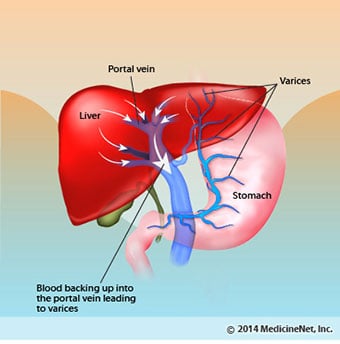 Edém, ascites a komplikácie bakteriálnej peritonitídy
Edém, ascites a komplikácie bakteriálnej peritonitídy Keď sa cirhóza pečene stane závažnou, do obličiek sa vysielajú signály, aby zadržali soľ a vodu v tele. Prebytočná soľ a voda sa najskôr hromadia v tkanive pod kožou členkov a nôh v dôsledku účinku gravitácie pri státí alebo sedení. Toto nahromadenie tekutiny sa nazýva periférny edém alebo jamkový edém. (Diskovitý edém sa vzťahuje na skutočnosť, že silné pritlačenie končeka prsta na členok alebo nohu s edémom spôsobí priehlbinu v koži, ktorá pretrváva ešte nejaký čas po uvoľnení tlaku. Akýkoľvek typ tlaku, napríklad z elastického pásu ponožky Opuch je často horší na konci dňa po postavení alebo sedení a môže sa cez noc zmenšiť, keď si ľahnete. Ako sa cirhóza zhoršuje a zadržiava sa viac soli a vody, tekutina sa môže hromadiť aj v brušnej dutine medzi brušnou stenou a brušnými orgánmi (tzv. ascites), čo spôsobuje opuch brucha, brušné ťažkosti a zvýšenie hmotnosti.
Tekutina v brušnej dutine (ascites) je ideálnym miestom pre rast baktérií. Normálne brušná dutina obsahuje veľmi malé množstvo tekutiny, ktorá dokáže dobre odolávať infekcii, a baktérie, ktoré sa dostanú do brucha (zvyčajne z čreva), sú zabité alebo si nájdu cestu do portálnej žily a do pečene, kde sú zabité. Pri cirhóze nie je tekutina, ktorá sa zhromažďuje v bruchu, schopná normálne odolávať infekcii. Navyše, viac baktérií si nájde cestu z čreva do ascitu. Pravdepodobne sa vyskytne infekcia v bruchu a ascites, nazývaná spontánna bakteriálna peritonitída alebo SBP. SBP je život ohrozujúca komplikácia. Niektorí pacienti s SBP nemajú žiadne príznaky, zatiaľ čo iní majú horúčku, triašku, bolesť brucha a citlivosť, hnačku a zhoršujúci sa ascites.
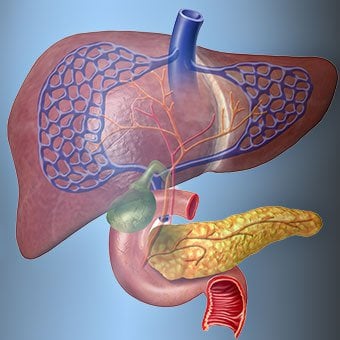 Krvácanie a komplikácie sleziny
Krvácanie a komplikácie sleziny V cirhotickej pečeni zjazvené tkanivo blokuje tok krvi vracajúcej sa do srdca z čriev a zvyšuje tlak v portálnej žile (portálna hypertenzia). Keď sa tlak v portálnej žile dostatočne zvýši, spôsobí to, že krv prúdi okolo pečene cez žily s nižším tlakom, aby sa dostala do srdca. Najčastejšími žilami, ktorými krv obchádza pečeň, sú žily lemujúce spodnú časť pažeráka a hornú časť žalúdka.
V dôsledku zvýšeného prietoku krvi a následného zvýšenia tlaku sa žily v dolnom pažeráku a hornom žalúdku rozširujú a potom sa označujú ako pažerákové a žalúdočné varixy; čím vyšší je portálny tlak, tým väčšie sú varixy a tým je pravdepodobnejšie, že pacient bude krvácať z varixov do pažeráka alebo žalúdka.
Krvácanie z varixov je závažné a bez okamžitej liečby môže byť smrteľné. Príznaky krvácania z varixov zahŕňajú vracanie krvi (môže sa javiť ako červená krv zmiešaná so zrazeninami alebo „kávovou usadeninou“), stolicu, ktorá je čierna a dechtovitá v dôsledku zmien v krvi pri prechode črevom (melena) a ortostatickú závraty alebo mdloby (spôsobené poklesom krvného tlaku najmä pri vstávaní z ľahu).
Krvácanie sa môže zriedkavo vyskytnúť z varixov, ktoré sa tvoria inde v črevách, napríklad v hrubom čreve. Pacienti hospitalizovaní pre aktívne krvácanie z pažerákových varixov majú vysoké riziko vzniku spontánnej bakteriálnej peritonitídy, aj keď dôvody ešte nie sú pochopené.
Slezina normálne funguje ako filter na odstránenie starších červených krviniek, bielych krviniek a krvných doštičiek (malé častice dôležité pre zrážanie krvi). Krv, ktorá odteká zo sleziny, sa spája s krvou v portálnej žile z čriev. Keď pri cirhóze stúpa tlak v portálnej žile, čoraz viac blokuje prietok krvi zo sleziny. Krv sa „hromadí“, hromadí sa v slezine a slezina sa zväčšuje, čo je stav označovaný ako splenomegália. Niekedy je slezina taká zväčšená, že spôsobuje bolesť brucha.
Ako sa slezina zväčšuje, filtruje stále viac krviniek a krvných doštičiek, až kým sa ich počet v krvi nezníži. Hypersplenizmus je termín používaný na opis tohto stavu a je spojený s nízkym počtom červených krviniek (anémia), nízkym počtom bielych krviniek (leukopénia) a/alebo nízkym počtom krvných doštičiek (trombocytopénia). Anémia môže spôsobiť slabosť, leukopénia môže viesť k infekciám a trombocytopénia môže zhoršiť zrážanlivosť krvi a viesť k predĺženému krvácaniu
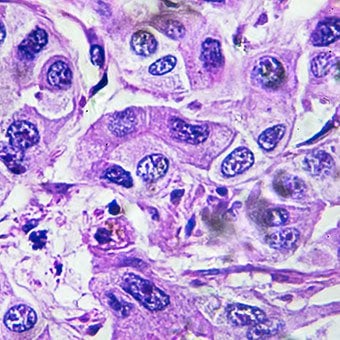 Pečeňové (pečeňové) komplikácie
Pečeňové (pečeňové) komplikácie Cirhóza z akejkoľvek príčiny zvyšuje riziko primárnej rakoviny pečene (hepatocelulárny karcinóm). Primárne sa týka skutočnosti, že nádor pochádza z pečene. Sekundárna rakovina pečene je rakovina, ktorá vzniká inde v tele a šíri sa (metastázuje) do pečene.
Najčastejšími príznakmi a príznakmi primárnej rakoviny pečene sú bolesť brucha a opuch, zväčšená pečeň, strata hmotnosti a horúčka. Okrem toho môže rakovina pečene produkovať a uvoľňovať množstvo látok vrátane tých, ktoré spôsobujú zvýšený počet červených krviniek (erytrocytózu), nízku hladinu cukru v krvi (hypoglykémiu) a vysokú hladinu vápnika v krvi (hyperkalciémiu).
Časť bielkovín v potravinách, ktoré unikajú tráveniu a vstrebávaniu, využívajú baktérie, ktoré sa bežne vyskytujú v čreve. Počas používania proteínu na svoje vlastné účely baktérie vytvárajú látky, ktoré uvoľňujú do čreva, aby sa potom absorbovali do tela. Niektoré z týchto látok, ako napríklad amoniak, môžu mať toxické účinky na mozog. Zvyčajne sú tieto toxické látky prenášané z čreva v portálnej žile do pečene, kde sú odstránené z krvi a detoxikované.
Keď je prítomná cirhóza, pečeňové bunky nemôžu normálne fungovať buď preto, že sú poškodené, alebo preto, že stratili svoj normálny vzťah s krvou. Okrem toho časť krvi v portálnej žile obchádza pečeň cez iné žily. Výsledkom týchto abnormalít je, že toxické látky nedokážu pečeňové bunky odstrániť a namiesto toho sa hromadia v krvi.
Keď sa toxické látky dostatočne nahromadia v krvi, funkcia mozgu je narušená, čo je stav nazývaný hepatálna encefalopatia. Spánok cez deň a nie v noci (obrátenie normálneho spánkového režimu) je skorým príznakom hepatálnej encefalopatie. Medzi ďalšie príznaky patrí podráždenosť, neschopnosť sústrediť sa alebo vykonávať výpočty, strata pamäti, zmätenosť alebo znížená úroveň vedomia. V konečnom dôsledku ťažká hepatálna encefalopatia spôsobuje kómu a smrť.
Toxické látky tiež spôsobujú, že mozgy pacientov s cirhózou sú veľmi citlivé na lieky, ktoré sú bežne filtrované a detoxikované pečeňou. Možno bude potrebné znížiť dávky mnohých liekov, aby sa predišlo toxickému nahromadeniu pri cirhóze, najmä sedatív a liekov používaných na podporu spánku. Alternatívne sa môžu použiť lieky, ktoré nie je potrebné detoxikovať alebo vylučovať z tela pečeňou, napríklad lieky vylučované obličkami.
U pacientov so zhoršujúcou sa cirhózou sa môže vyvinúť hepatorenálny syndróm. Tento syndróm je závažnou komplikáciou, pri ktorej je znížená funkcia obličiek. Ide o funkčný problém v obličkách, čo znamená, že nedochádza k fyzickému poškodeniu obličiek. Namiesto toho je znížená funkcia spôsobená zmenami v spôsobe, akým krv prúdi cez samotné obličky. Hepatorenálny syndróm je definovaný ako progresívne zlyhanie obličiek pri odstraňovaní látok z krvi a produkcii dostatočného množstva moču, pričom ostatné dôležité funkcie obličiek, ako je retencia soli, sú zachované. Ak sa zlepší funkcia pečene alebo sa pacientovi s hepatorenálnym syndrómom transplantuje zdravá pečeň, obličky zvyčajne začnú opäť normálne fungovať. To naznačuje, že znížená funkcia obličiek je výsledkom buď akumulácie toxických látok v krvi alebo abnormálnej funkcie pečene, keď pečeň zlyhá. Existujú dva typy hepatorenálneho syndrómu. Jeden typ sa vyskytuje postupne v priebehu mesiacov. Druhá nastáva rýchlo v priebehu týždňa alebo dvoch.
Zriedkavo sa u niektorých pacientov s pokročilou cirhózou môže vyvinúť hepatopulmonálny syndróm. Títo pacienti môžu mať ťažkosti s dýchaním, pretože určité hormóny uvoľňované pri pokročilej cirhóze spôsobujú abnormálne fungovanie pľúc. Základným problémom v pľúcach je, že cez malé krvné cievy v pľúcach, ktoré sú v kontakte s alveolami (vzduchovými vakmi) pľúc, nepreteká dostatok krvi. Krv prúdiaca cez pľúca sa presúva okolo alveol a nemôže zo vzduchu v alveolách zachytiť dostatok kyslíka. Výsledkom je, že pacient pociťuje dýchavičnosť, najmä pri námahe.
 Existuje 12 bežných príčin cirhózy.
Existuje 12 bežných príčin cirhózy. Bežné príčiny cirhózy pečene zahŕňajú:
Less common causes of cirrhosis include:
In certain parts of the world (particularly Northern Africa), infection of the liver with a parasite (schistosomiasis) is the most common cause of liver disease and cirrhosis.
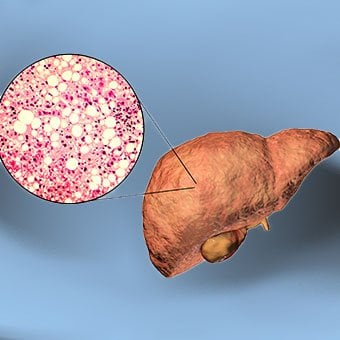 Alcohol and nonalcoholic fatty liver disease are common causes of cirrhosis.
Alcohol and nonalcoholic fatty liver disease are common causes of cirrhosis. Alcohol is a very common cause of cirrhosis, particularly in the Western world. Chronic, high levels of alcohol consumption injure liver cells. Thirty percent of individuals who drink daily at least eight to sixteen ounces of hard liquor or the equivalent for fifteen or more years will develop cirrhosis. Alcohol causes a range of liver diseases, which include simple and uncomplicated fatty liver (steatosis), more serious fatty liver with inflammation (steatohepatitis or alcoholic hepatitis), and cirrhosis.
Nonalcoholic fatty liver disease (NAFLD) refers to a wide spectrum of liver diseases that, like alcoholic liver disease, range from simple steatosis, to nonalcoholic steatohepatitis (NASH), to cirrhosis. All stages of NAFLD have in common the accumulation of fat in liver cells. The term nonalcoholic is used because NAFLD occurs in individuals who do not consume excessive amounts of alcohol, yet in many respects the microscopic picture of NAFLD is similar to what can be seen in liver disease that is due to excessive alcohol. NAFLD is associated with a condition called insulin resistance, which, in turn, is associated with metabolic syndrome and diabetes mellitus type 2. Obesity is the main cause of insulin resistance, metabolic syndrome, and type 2 diabetes. NAFLD is the most common liver disease in the United States and is responsible for up to 25% of all liver disease. The number of livers transplanted for NAFLD-related cirrhosis is on the rise. Public health officials are worried that the current epidemic of obesity will dramatically increase the development of NAFLD and cirrhosis in the population.
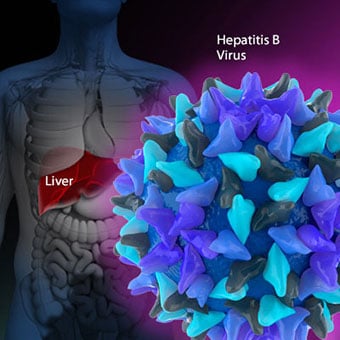 Primary biliary cirrhosis (PBC) is a liver disease caused by an abnormality of the immune system that is found predominantly in women.
Primary biliary cirrhosis (PBC) is a liver disease caused by an abnormality of the immune system that is found predominantly in women. Chronic viral hepatitis is a condition in which hepatitis B or hepatitis C virus infects the liver for years. Most patients with viral hepatitis will not develop chronic hepatitis and cirrhosis. The majority of patients infected with hepatitis A recover completely within weeks, without developing chronic infection. In contrast, some patients infected with hepatitis B virus and most patients infected with hepatitis C virus develop chronic hepatitis, which, in turn, causes progressive liver damage and leads to cirrhosis, and, sometimes, liver cancers.
Autoimmune hepatitis is a liver disease found more commonly in women that is caused by an abnormality of the immune system. The abnormal immune activity in autoimmune hepatitis causes progressive inflammation and destruction of liver cells (hepatocytes), leading ultimately to cirrhosis.
Primary biliary cirrhosis (PBC) is a liver disease caused by an abnormality of the immune system that is found predominantly in women. The abnormal immunity in PBC causes chronic inflammation and destruction of the small bile ducts within the liver. The bile ducts are passages within the liver through which bile travels to the intestine. Bile is a fluid produced by the liver that contains substances required for digestion and absorption of fat in the intestine, as well as other compounds that are waste products, such as the pigment bilirubin. (Bilirubin is produced by the breakdown of hemoglobin from old red blood cells.). Along with the gallbladder, the bile ducts make up the biliary tract. In PBC, the destruction of the small bile ducts blocks the normal flow of bile into the intestine. As the inflammation continues to destroy more of the bile ducts, it also spreads to destroy nearby liver cells. As the destruction of the hepatocytes proceeds, scar tissue (fibrosis) forms and spreads throughout the areas of destruction. The combined effects of progressive inflammation, scarring, and the toxic effects of accumulating waste products culminates in cirrhosis.
Primary sclerosing cholangitis (PSC) is an uncommon disease frequently found in patients with Crohn's disease and ulcerative colitis. In PSC, the large bile ducts outside of the liver become inflamed, narrowed, and obstructed. Obstruction to the flow of bile leads to infections of the bile ducts and jaundice, eventually causing cirrhosis. In some patients, injury to the bile ducts (usually because of surgery) also can cause obstruction and cirrhosis of the liver.
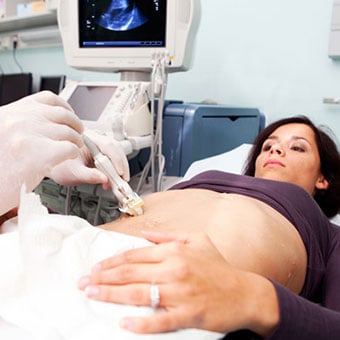 Different liver diseases should be diagnosed by specialists and different tests such as liver blood test, biopsy, and others.
Different liver diseases should be diagnosed by specialists and different tests such as liver blood test, biopsy, and others. Inherited (genetic) disorders that result in the accumulation of toxic substances in the liver, which leads to tissue damage and cirrhosis. Examples include the abnormal accumulation of iron (hemochromatosis) or copper (Wilson disease). In hemochromatosis, patients inherit a tendency to absorb an excessive amount of iron from food. Over time, iron accumulation in different organs throughout the body causes cirrhosis, arthritis, heart muscle damage leading to heart failure, and testicular dysfunction causing loss of sexual drive. Treatment is aimed at preventing damage to organs by removing iron from the body through phlebotomy (removing blood). In Wilson disease, there is an inherited abnormality in one of the proteins that control copper in the body. Over time, copper accumulates in the liver, eyes, and brain. Cirrhosis, tremor, psychiatric disturbances, and other neurological difficulties occur if the condition is not treated early. Treatment is with oral medication, which increases the amount of copper that is eliminated from the body in the urine.
Cryptogenic cirrhosis (cirrhosis due to unidentified causes) is a common reason for liver transplantation. It is termed called cryptogenic cirrhosis because for many years doctors have been being unable to explain why a proportion of patients developed cirrhosis. Doctors now believe that cryptogenic cirrhosis is due to NASH (nonalcoholic steatohepatitis) caused by long-standing obesity, type 2 diabetes, and insulin resistance. The fat in the liver of patients with NASH is believed to disappear with the onset of cirrhosis, and this has made it difficult for doctors to make the connection between NASH and cryptogenic cirrhosis for a long time. One important clue that NASH leads to cryptogenic cirrhosis is the finding of a high occurrence of NASH in the new livers of patients undergoing liver transplant for cryptogenic cirrhosis. Finally, a study from France suggests that patients with NASH have a similar risk of developing cirrhosis as patients with long-standing infection with hepatitis C virus. (See discussion that follows.) However, the progression to cirrhosis from NASH is thought to be slow and the diagnosis of cirrhosis typically is made in people in their sixties.
Infants can be born without bile ducts (biliary atresia) and ultimately develop cirrhosis. Other infants are born lacking vital enzymes for controlling sugars that lead to the accumulation of sugars and cirrhosis. On rare occasions, the absence of a specific enzyme can cause cirrhosis and scarring of the lung (alpha-1 antitrypsin deficiency).
Less common causes of cirrhosis include unusual reactions to some drugs and prolonged exposure to toxins, as well as chronic heart failure (cardiac cirrhosis). In certain parts of the world (particularly Northern Africa), infection of the liver with a parasite (schistosomiasis) is the most common cause of liver disease and cirrhosis.
 Different liver diseases should be diagnosed by specialists and different tests such as liver blood test, biopsy, and others.
Different liver diseases should be diagnosed by specialists and different tests such as liver blood test, biopsy, and others. The single best test for diagnosing cirrhosis is a biopsy of the liver. Liver biopsies carry a small risk for serious complications, and biopsy often is reserved for those patients in whom the diagnosis of the type of liver disease or the presence of cirrhosis is not clear. The history, physical examination, or routine testing may suggest the possibility of cirrhosis. If cirrhosis is present, other tests can be used to determine the severity of the cirrhosis and the presence of complications. Tests also may be used to diagnose the underlying disease that is causing the cirrhosis. Examples of how doctors diagnose and evaluate cirrhosis are:
 There are four types of treatment of cirrhosis.
There are four types of treatment of cirrhosis. Treatment of cirrhosis includes
Consume a balanced diet and one multivitamin daily. Patients with PBC with impaired absorption of fat-soluble vitamins may need additional vitamins D and K.
Avoid drugs (including alcohol) that cause liver damage. All patients with cirrhosis should avoid alcohol. Most patients with alcohol-induced cirrhosis experience an improvement in liver function with abstinence from alcohol. Even patients with chronic hepatitis B and C can substantially reduce liver damage and slow the progression towards cirrhosis with abstinence from alcohol.
Avoid nonsteroidal anti-inflammatory drugs (NSAIDs, e.g., ibuprofen). Patients with cirrhosis can experience worsening of liver and kidney function with NSAIDs.
Eradicate hepatitis B and hepatitis C virus by using anti-viral medications. Not all patients with cirrhosis due to chronic viral hepatitis are candidates for drug treatment. Some patients may experience serious deterioration in liver function and/or intolerable side effects during treatment. Thus, decisions to treat viral hepatitis have to be individualized, after consulting with doctors experienced in treating liver diseases (hepatologists).
Remove blood from patients with hemochromatosis to reduce the levels of iron and prevent further damage to the liver. In Wilson's disease, medications can be used to increase the excretion of copper in the urine to reduce the levels of copper in the body and prevent further damage to the liver.
Suppress the immune system with drugs such as prednisone and azathioprine (Imuran) to decrease inflammation of the liver in autoimmune hepatitis.
Treat patients with PBC with a bile acid preparation, ursodeoxycholic acid (UDCA), also called ursodiol (Actigall). Results of an analysis that combined the results from several clinical trials showed that UDCA increased survival among PBC patients during 4 years of therapy. The development of portal hypertension also was reduced by the UDCA. It is important to note that despite producing clear benefits, UDCA treatment primarily retards progression and does not cure PBC. Other medications such as colchicine and methotrexate also may have benefits in subsets of patients with PBC.
Immunize patients with cirrhosis against infection with hepatitis A and B to prevent a serious deterioration in liver. There are currently no vaccines available for immunizing against hepatitis C.
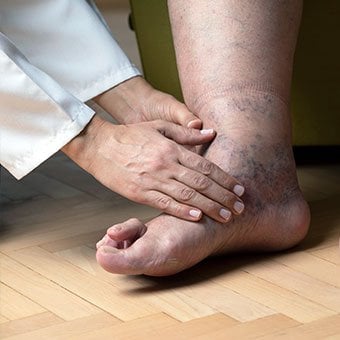 Treatment for edema, ascites, and hypersplenism complications.
Treatment for edema, ascites, and hypersplenism complications. Retaining salt and water can lead to swelling of the ankles and legs (edema) or abdomen (ascites) in patients with cirrhosis. Doctors often advise patients with cirrhosis to restrict dietary salt (sodium) and fluid to decrease edema and ascites. The amount of salt in the diet usually is restricted to 2 grams per day and fluid to 1.2 liters per day. In most patients with cirrhosis, salt and fluid restriction is not enough and diuretics have to be added.
Diuretics are medications that work in the kidneys to promote the elimination of salt and water into the urine. A combination of the diuretics spironolactone (Aldactone) and furosemide (Lasix) can reduce or eliminate the edema and ascites in most patients. During treatment with diuretics, it is important to monitor the function of the kidneys by measuring blood levels of blood urea nitrogen (BUN) and creatinine to determine if too much diuretic is being used. Too much diuretic can lead to kidney dysfunction that is reflected in elevations of the BUN and creatinine levels in the blood.
Sometimes, when the diuretics do not work (in which case the ascites is said to be refractory), a long needle or catheter is used to draw out the ascitic fluid directly from the abdomen, a procedure called abdominal paracentesis. It is common to withdraw large amounts (liters) of fluid from the abdomen when the ascites is causing painful abdominal distension and/or difficulty breathing because it limits the movement of the diaphragms.
Another treatment for refractory ascites is a procedure called transjugular intravenous portosystemic shunting (TIPS).
The spleen normally acts as a filter to remove older red blood cells, white blood cells, and platelets (small particles important for the clotting of blood). The blood that drains from the spleen joins the blood in the portal vein from the intestines. As the pressure in the portal vein rises in cirrhosis, it increasingly blocks the flow of blood from the spleen. The blood "backs-up," accumulating in the spleen, and the spleen swells in size, a condition referred to as splenomegaly. Sometimes, the spleen is so enlarged it causes abdominal pain.
As the spleen enlarges, it filters out more and more of the blood cells and platelets until their numbers in the blood are reduced. Hypersplenism is the term used to describe this condition, and it is associated with a low red blood cell count (anemia), low white blood cell count (leukopenia), and/or a low platelet count (thrombocytopenia). Anemia can cause weakness, leucopenia can lead to infections, and thrombocytopenia can impair the clotting of blood and result in prolonged bleeding.
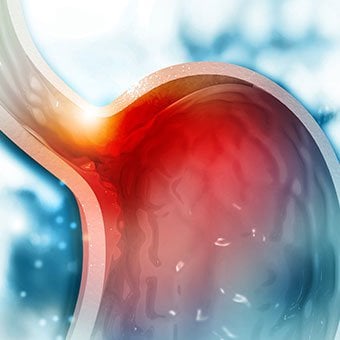 Once varices have bled, they tend to rebleed and the probability that a patient will die from each bleeding episode is high (30% to 35%). Treatment is necessary to prevent the first bleeding episode as well as rebleeding.
Once varices have bled, they tend to rebleed and the probability that a patient will die from each bleeding episode is high (30% to 35%). Treatment is necessary to prevent the first bleeding episode as well as rebleeding. If large varices develop in the esophagus or upper stomach, patients with cirrhosis are at risk for serious bleeding due to rupture of these varices. Once varices have bled, they tend to rebleed and the probability that a patient will die from each bleeding episode is high (30% to 35%). Treatment is necessary to prevent the first bleeding episode as well as rebleeding. Treatments include medications and procedures to decrease the pressure in the portal vein and procedures to destroy the varices.
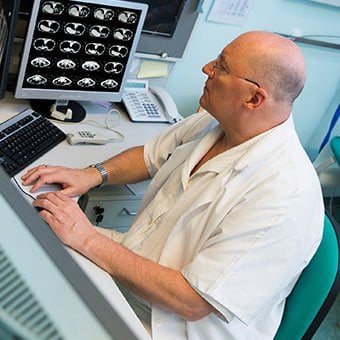 Hepatic encephalopathy usually should be treated with a low protein diet and oral lactulose.
Hepatic encephalopathy usually should be treated with a low protein diet and oral lactulose. Patients with an abnormal sleep cycle, impaired thinking, odd behavior, or other signs of hepatic encephalopathy usually should be treated with a low protein diet and oral lactulose. Dietary protein is restricted because it is a source of toxic compounds that cause hepatic encephalopathy. Lactulose, which is a liquid, traps toxic compounds in the colon so they cannot be absorbed into the bloodstream, and thus cause encephalopathy. Lactulose is converted to lactic acid in the colon, and the acidic environment that results is believed to trap the toxic compounds produced by the bacteria. To be sure adequate lactulose is present in the colon at all times, the patient should adjust the dose to produce 2 to 3 semiformed bowel movements a day. Lactulose is a laxative, and the effectiveness of treatment can be judged by loosening or increasing the frequency of stools. Rifaximin (Xifaxan) is an antibiotic taken orally that is not absorbed into the body but rather remains in the intestines. It is the preferred mode of treatment of hepatic encephalopathy. Antibiotics work by suppressing the bacteria that produce the toxic compounds in the colon.
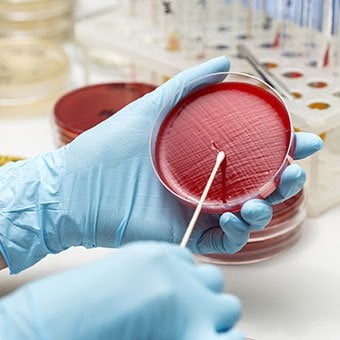 Most patients with spontaneous bacterial peritonitis are hospitalized and treated with intravenous antibiotics.
Most patients with spontaneous bacterial peritonitis are hospitalized and treated with intravenous antibiotics. Patients suspected of having spontaneous bacterial peritonitis usually will undergo paracentesis. The fluid that is removed is examined for white blood cells and cultured for bacteria. Culturing involves inoculating a sample of the ascites into a bottle of nutrient-rich fluid that encourages the growth of bacteria, thus facilitating the identification of even small numbers of bacteria. Blood and urine samples also are often obtained for culturing because many patients with spontaneous bacterial peritonitis also will have infections in their blood and urine. Many doctors believe the infection may have begun in the blood and the urine and spread to the ascitic fluid to cause spontaneous bacterial peritonitis. Most patients with spontaneous bacterial peritonitis are hospitalized and treated with intravenous antibiotics such as cefotaxime (Claforan). Patients usually treated with antibiotics include:
Spontaneous bacterial peritonitis is a serious infection. It often occurs in patients with advanced cirrhosis whose immune systems are weak, but with modern antibiotics and early detection and treatment, the prognosis of recovering from an episode of spontaneous bacterial peritonitis is good.
In some patients, oral antibiotics (norfloxacin [Noroxin] or sulfamethoxazole and trimethoprim [Bactrim]) can be prescribed to prevent spontaneous bacterial peritonitis. Not all patients with cirrhosis and ascites should be treated with antibiotics to prevent spontaneous bacterial peritonitis, but some patients are at high risk for developing spontaneous bacterial peritonitis and warrant preventive treatment.
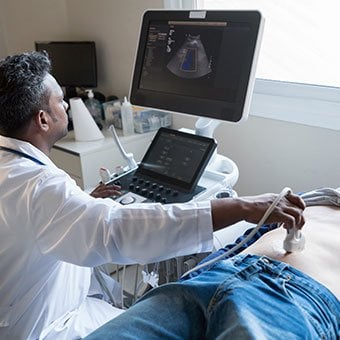 The prognosis and life expectancy for cirrhosis of the liver varies and depends on the cause, the severity, any complications, and any underlying diseases.
The prognosis and life expectancy for cirrhosis of the liver varies and depends on the cause, the severity, any complications, and any underlying diseases. Several types of liver disease that cause cirrhosis (such as hepatitis B and C) are associated with a high incidence of liver cancer. It is useful to screen for liver cancer in patients with cirrhosis, as early surgical treatment or transplantation of the liver can cure the patient of cancer. The difficulty is that the methods available for screening are only partially effective, identifying at best only half of patients at a curable stage of their cancer. Despite the partial effectiveness of screening, most patients with cirrhosis, particularly hepatitis B and C, are screened yearly or every six months with ultrasound examination of the liver and measurements of cancer-produced proteins in the blood, for example, alpha-fetoprotein.
Cirrhosis is irreversible. Liver function usually gradually worsens despite treatment, and complications of cirrhosis increase and become difficult to treat. When cirrhosis is far advanced liver transplantation often is the only option for treatment. Recent advances in surgical transplantation and medications to prevent infection and rejection of the transplanted liver have greatly improved survival after transplantation. On average, more than 80% of patients who receive transplants are alive after five years. Not everyone with cirrhosis is a candidate for transplantation. Furthermore, there is a shortage of livers to transplant, and they're usually is a long (months to years) wait before a liver for transplanting becomes available. Measures to slow the progression of liver disease, and treat and prevent complications of cirrhosis are vitally important.
The prognosis and life expectancy for cirrhosis of the liver varies and depends on the cause, the severity, any complications, and any underlying diseases.
Progress in the management and prevention of cirrhosis continues. Research is ongoing to determine the mechanism of scar formation in the liver and how this process of scarring can be interrupted or even reversed. Newer and better treatments for viral liver disease are being developed to prevent the progression to cirrhosis. Prevention of viral hepatitis by vaccination, which is available for hepatitis B, is being developed for hepatitis C. Treatments for the complications of cirrhosis are being developed or revised, and tested continually. Finally, research is being directed at identifying new proteins in the blood that can detect liver cancer early or predict which patients will develop liver cancer.
 Čo potrebujete vedieť o bylinných stimulačných laxatívach
Byliny známe pre svoje laxatívne účinky nájdete v rôznych doplnkoch stravy, čajoch na chudnutie a prípravkoch na čistenie hrubého čreva. Predtým, ako sa zamyslíte nad použitím jedného z týchto produkt
Čo potrebujete vedieť o bylinných stimulačných laxatívach
Byliny známe pre svoje laxatívne účinky nájdete v rôznych doplnkoch stravy, čajoch na chudnutie a prípravkoch na čistenie hrubého čreva. Predtým, ako sa zamyslíte nad použitím jedného z týchto produkt
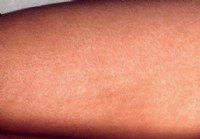 Scarlet Fever (Scarlatina)
Fakty, ktoré by ste mali vedieť o šarlach Obrázok vyrážky na paži v dôsledku šarlachu. Zdroj:CDC Šarlach je bakteriálna infekcia spôsobená Streptokokom skupiny A baktérie, ktorá má za následok vyrážk
Scarlet Fever (Scarlatina)
Fakty, ktoré by ste mali vedieť o šarlach Obrázok vyrážky na paži v dôsledku šarlachu. Zdroj:CDC Šarlach je bakteriálna infekcia spôsobená Streptokokom skupiny A baktérie, ktorá má za následok vyrážk
 Ako sa lieči rakovina pažeráka
Ako pri väčšine typov rakoviny, liečba rakoviny pažeráka závisí z veľkej časti od jej pokročilosti. Keď sa zachytí v počiatočnom štádiu, ešte predtým, ako sa dostane za pažerák, jeho odstránenie pomoc
Ako sa lieči rakovina pažeráka
Ako pri väčšine typov rakoviny, liečba rakoviny pažeráka závisí z veľkej časti od jej pokročilosti. Keď sa zachytí v počiatočnom štádiu, ešte predtým, ako sa dostane za pažerák, jeho odstránenie pomoc